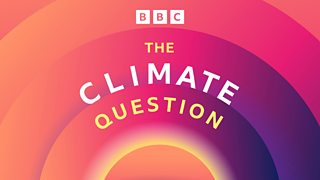What you need to know about 1.5C
You've probably heard it mentioned again and again.
In recent years, TV shows, films, podcasts, social feeds, magazines and celebrities have been talking about something called 1.5C. Now you may have only a vague idea what this means, but rest assured you're not alone – plenty of us would struggle to explain exactly what it is.
To get some answers, Jordan Dunbar of Βι¶ΉΤΌΕΔ World Service's The Climate Question spoke to climate scientist Adam Levy (aka Climate Adam on social media).
What is 1.5C?
In a landmark deal signed in Paris in 2015, the UK and almost 200 other countries agreed to take action to limit the global average temperature to 1.5C above pre-industrial levels. This legally binding international treaty on climate change also included a separate goal to hold the increase to well below 2C.
"1.5C of warming came into everyone's consciousness as part of the Paris climate agreement," explained Levy. "It was actually the more ambitious part of that agreement. It said we should limit global warming to 2C and, if we're really good, let's try and limit global warming to 1.5C."
In case you're wondering where things stand, the World Meteorological Organization (WMO) said that the global average temperature in 2022 was already about 1.15C warmer than pre-industrial levels.

Why 1.5C?
You might be wondering why 1.5C was chosen as the target, rather than say 1.4C or 1.6C.
"The 1.5C figure is not some random statistic," said WMO secretary-general Prof Petteri Taalas. "It is rather an indicator of the point at which climate impacts will become increasingly harmful for people and indeed the entire planet."
Crossing the 1.5C threshold risks triggering far more severe climate change impacts such as frequent and serious heatwaves and droughts, according to the UN's Intergovernmental Panel on Climate Change. It would also lead to sea levels rising significantly, threatening the future of low-lying countries and island nations.

Is it an all-or-nothing target?
It’s worth considering the impact of just nudging over 1.5C, compared to overshooting it by a huge margin.
"If we do pass 1.5C, that doesn't mean game over," said Levy. "It's not like a switch that takes us from everything was fine to world over."
In fact, every rise by a tenth of a degree is likely to increase the frequency and severity of extreme weather events. The Intergovernmental Panel on Climate Change said that coral reefs will decline by 70-90% if we limit global warming to 1.5C, for example, but more than 99% will be lost if the temperature climbs by 2C.
"There's a world of difference between every fraction of a degree of global warming," added Levy.

What are governments doing about it?
To help keep the world below 1.5C, many countries, regions and cities have pledged to go 'net zero' – cutting their greenhouse gas emissions to as close to zero as possible, with all remaining emissions reabsorbed from the atmosphere, by oceans and forests for instance.
However, experts are concerned that some governments aren’t taking the actions necessary to deliver on their promises. And they worry that global commitments to date don’t show anywhere near enough ambition.
"There is no person or economy left on the planet untouched by climate change, so we need to stop setting unwanted records on greenhouse gas emissions, global temperature highs and extreme weather," said UN Environment Programme (UNEP) climate change coordinator Inger Andersen in November 2023. "We must instead lift the needle out of the same old groove of insufficient ambition and not enough action, and start setting other records: on cutting emissions, on green and just transitions and on climate finance."
There are lots of policies that can support the drive towards net zero. These include:
- Switching from fossil fuels to renewable energy
- Protecting existing forests and planting new ones
- Scaling up climate finance
According to the UN, the world needs to reach net-zero emissions by 2050 to keep global warming to no more than 1.5C.

What can I do about it?
It isn't just governments that can take action to prevent the temperature passing 1.5C.
"We need to get to net-zero greenhouse gas emissions by 2050 and everyone has a role to play," said UNEP climate change coordinator Niklas Hagelberg. "We, as individuals, must change our consumption habits and pressure those who represent us – our employers, our politicians – to move rapidly to a low-carbon world."
Here are some climate-friendly measures we could incorporate into our lives:
- Take fewer flights
- Switch to electric vehicles
- Insulate homes
- Plant trees
- Buy energy-efficient products
- Eat less meat
- Reduce food waste
- Buy fewer new clothes

What's the outlook?
There's no getting away from the fact that experts have been disappointed with the rate of progress in recent years.
The planet is far off track from meeting its climate goals, according to a report coordinated by the WMO published in September 2023. "The science continues to show that we are not doing enough to lower emissions and meet the goals of the Paris Agreement," said Andersen.
All is not lost, however, and there's still time to turn things around.
"We know it is still possible to make the 1.5-degree limit a reality," said UN Secretary General António Guterres in November 2023. "It requires tearing out the poisoned root of the climate crisis: fossil fuels. And it demands a just, equitable renewables transition."
"There's nothing in the physics of how the atmosphere or the climate work that says 1.5C is off the table," concluded Levy. "That is until we have passed it. And so, since we are still under 1.5C of global warming, we should really be fighting to stay under with everything we've got."
-
![]()
Check out this simple guide to climate change
What's causing the Earth to heat up?
-
![]()
Discover why COP matters
The Climate Question presents a beginner's guide to the international climate conference
-
![]()
Find out more about The Climate Question
A Βι¶ΉΤΌΕΔ World Service programme investigating the climate crisis




